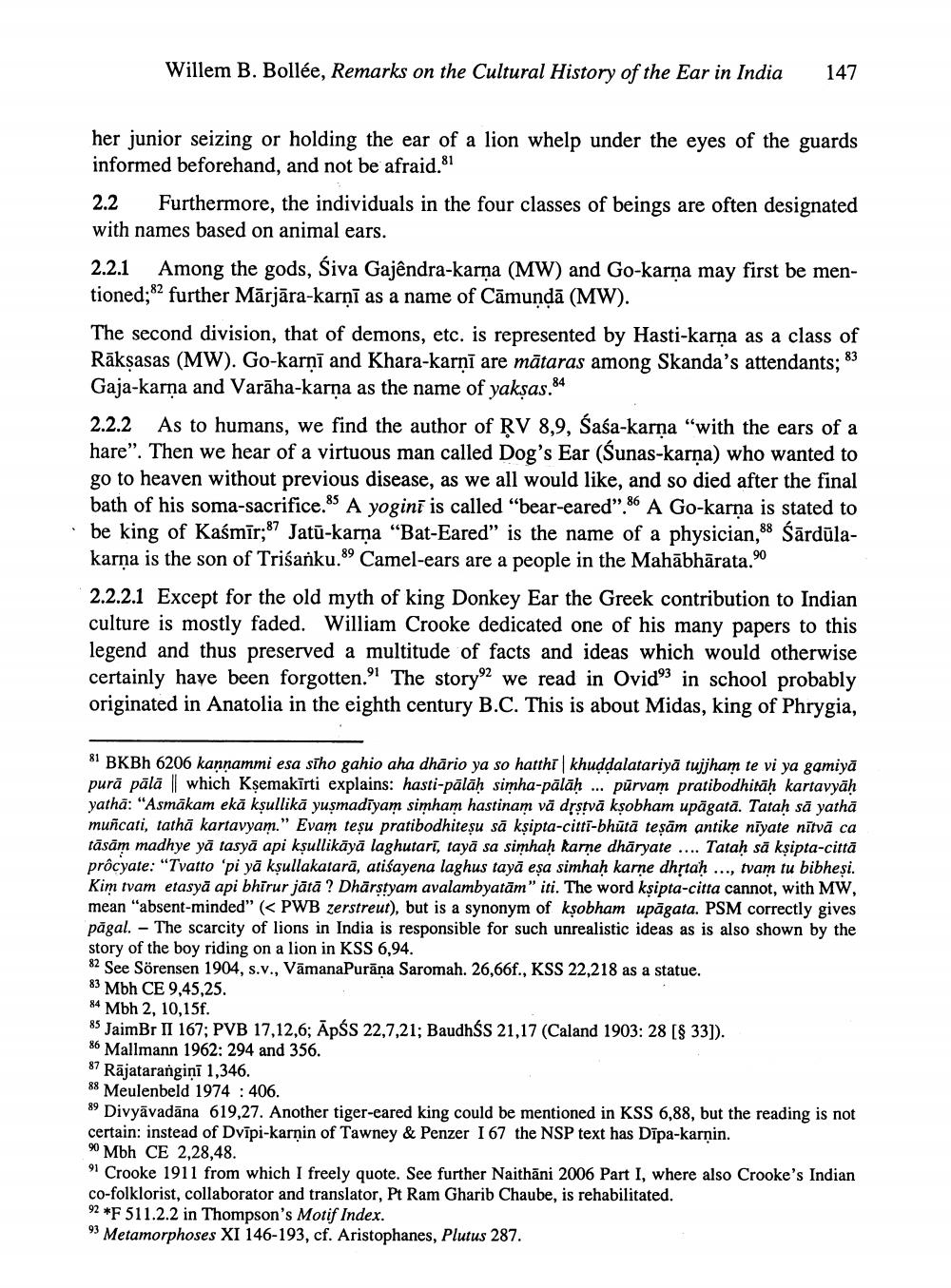________________
Willem B. Bollée, Remarks on the Cultural History of the Ear in India
147
her junior seizing or holding the ear of a lion whelp under the eyes of the guards informed beforehand, and not be afraid. 81 2.2 Furthermore, the individuals in the four classes of beings are often designated with names based on animal ears. 2.2.1 Among the gods, Siva Gajendra-karņa (MW) and Go-karņa may first be mentioned; 82 further Mārjāra-karņī as a name of Cāmundā (MW). The second division, that of demons, etc. is represented by Hasti-karņa as a class of Rākşasas (MW). Go-karņī and Khara-karnī are mātaras among Skanda's attendants; 83 Gaja-karņa and Varāha-karņa as the name of yakşas. 84 2.2.2 As to humans, we find the author of RV 8,9, Śaśa-karņa “with the ears of a hare”. Then we hear of a virtuous man called Dog's Ear (Sunas-karna) who wanted to go to heaven without previous disease, as we all would like, and so died after the final bath of his soma-sacrifice. 85 A yoginī is called "bear-eared”. 86 A Go-karna is stated to be king of Kaśmīr;87 Jatū-karna "Bat-Eared” is the name of a physician, 88 Sārdülakarna is the son of Trišanku.89 Camel-ears are a people in the Mahābhārata.90 2.2.2.1 Except for the old myth of king Donkey Ear the Greek contribution to Indian culture is mostly faded. William Crooke dedicated one of his many papers to this legend and thus preserved a multitude of facts and ideas which would otherwise certainly have been forgotten. The story92 we read in Ovido in school probably originated in Anatolia in the eighth century B.C. This is about Midas, king of Phrygia,
81 BKBh 6206 kannammi esa sīho gahio aha dhārio ya so hatthi khuddalatariyā tujjham te vi ya gamiyā purā pālā || which Kșemakīrti explains: hasti-pālāḥ simha-pālāḥ ... pūrvam pratibodhitāḥ kartavyāḥ yathā: "Asmākam ekā kșullik, yuşmadiyam simham hastinam vā drstvā kşobham upāgatā. Tataḥ sā yathā muñcati, tathā kartavyam." Evam teșu pratibodhiteșu sa kşipta-citti-bhūtā teșām antike nīyate nītvā ca tāsām madhye yā tasyā api kșullikāyā laghutari, tayā sa simhaḥ karne dhāryate .... Tataḥ sā kşipta-città procyate: "Tvatto 'pi yā kşullakatarā, atiśayena laghus tayā eșa simhaḥ karne dhţtah ..., tvam tu bibheși. Kim tvam etasyā api bhīrur jātā ? Dhārstyam avalambyatām" iti. The word kşipta-citta cannot, with MW, mean "absent-minded" (< PWB zerstreut), but is a synonym of kşobham upāgata. PSM correctly gives pāgal. - The scarcity of lions in India is responsible for such unrealistic ideas as is also shown by the story of the boy riding on a lion in KSS 6,94. 82 See Sörensen 1904, s.v., VāmanaPurāna Saromah. 26,66f.. KSS 22.218 as a statue. 83 Mbh CE 9,45,25. 84 Mbh 2, 10,15f. 85 JaimBr II 167; PVB 17,12,6; ĀPŠS 22,7,21; BaudhŚs 21,17 (Caland 1903: 28 [33]). 86 Mallmann 1962: 294 and 356. 87 Rājatarangiņī 1,346. 88 Meulenbeld 1974 : 406. 89 Divyāvadāna 619,27. Another tiger-eared king could be mentioned in KSS 6,88, but the reading is not certain: instead of Dvipi-karņin of Tawney & Penzer 167 the NSP text has Dīpa-karņin. 90 Mbh CE 2,28,48. 91 Crooke 1911 from which I freely quote. See further Naithāni 2006 Part I, where also Crooke's Indian co-folklorist, collaborator and translator, Pt Ram Gharib Chaube, is rehabilitated. 92 *F 511.2.2 in Thompson's Motif Index. 93 Metamorphoses XI 146-193, cf. Aristophanes, Plutus 287.




